 |
|
 |
Bunkertour
2009 |
|
 |
Normandy,
France |
|
|
|
Normandy, Frankreich
For summer 2009 I was planning to do an extensive Bunkertour
again. After visiting 2008 the area of Pas-de-Calais in France,
which I thought was incredibly interesting, this time I would try
to see the beaches of the invasion in Normandy and its bunkers and
fortresses. Like I always do I started research in spring to
figure out more about the invasions exact history, the beaches
involved and what is left of it today. Rather soon it was clear,
that I would have to go see Omaha Beach as the main "attraction"
and the fortifications around it. Contrary to my tours the last
few years, this would be more geared towards attending museums and
fewer bunkers. Of course this was changed once we were actually
there, but the plan was different... It was nice, that my friend
Robert went with me on this tour and this time I did the
translations. I still speak somewhat reasonable french but it
proved to be not too important as Normandy is really catering to
british and american tourists and thus english is quite well
understood there. The plan was pretty strict - within three days
we would drive to France, see a whole bunch of museums and bunkers,
spend two nights in a tent on a camping ground close to the coast
and would drive back to Germany. 2100km in three days - quite a
feat...
Our plan was to drive to France the
first day, see the famous "Pegasus Bridge" back in the
Sword Beach area (known maybe from the movie The longest day) and
see the battery of Merville. due to the long ride we would then
already go to the camoing site to erect the tent, set up the BBQ
and prepare for the next day. The second day we would then go see
the german Widerstandsnest WN62 directly at Omaha Beach as the
main "attraction", some museums about the landing in
Normandy and another battery. As an optional target we thought
about going to St Mere Eglise with a museum and the church court.
The third day would compromise of two more batterys and the Point
du Hoc as the main target, then return to Germany by car to arrive
late at night. We changed the order of places to visit once there
on the second day, since we figured out that we could see a lot
more things in shorter time then planned.
The drive to France was for once
really unspectacular. It was just very long. Traffic was not too
dense, not too many traffic jams, the ride through Belgium and
France took long due to speed limits. At least our new car held up
well, the AC kept us cool, the freezer box took care of keeping
our drinks and food at a chilly temperature and being a station
wagon we had quite some room in it. Also proprogramming the GPS
unit was a good idea, I only had to select where to go each time
and the rest worked by itself. neat. We also carried a few extra
freezer bags since we had food and drinks for two days with us,
and they worked sufficiently. Overprepared maybe but thats the way
I plan those vacations. ;)
Following seven and a half hours of
driving (and maybe 20 minutes of breaks in between) we arrived in
the early afternoon in sunny weather at our first target for the
day, the Battery of Merville. Immediately I saw the nicely
kept DC3 plane there, which we could climb later on. Very nice,
such a plane was used to drop the paratroppers in this are to
conquer the german fortifications. It was not announced that this
plane was on display since they just got it in, but that was a
nice surprise for the start. We got our tickets and then checked
out the plane first.
Größere Kartenansicht
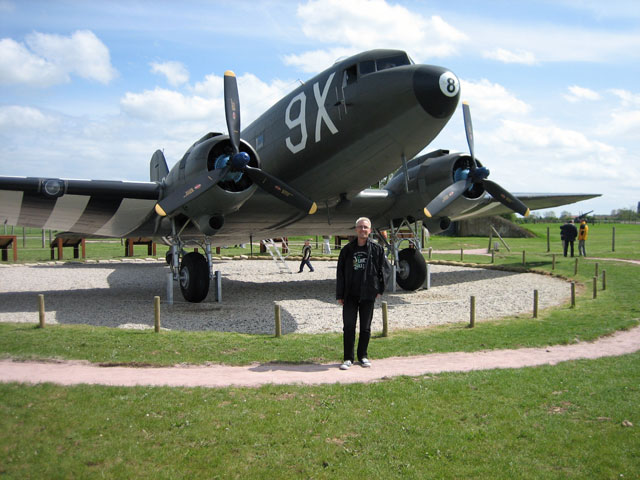
(Well kept DC3 at the Battery of Merville.)
The bunkers in the background are
as I researched beforehand rather small - no comparison to the
massive forts of the Maginotline, the ofrts of the first world war
or the huge V-Waepon bunkers. Not to speak of the
"Ostwall" fortification, the bore most resemblance to
the small bunkers and pillboxes of the Westwall. After we were
done checking out the plane and its interior we took a look at all
the bunkers in the area. Unfortunately we could only walk into two
of them, the others are sealed shut or filled with water. But just
those two give a good impression on what the looked like back in
the daay and how they look now.

(Bunker Number 4 - one of the bunkers
protecting the guns of Merville.)
The last bunker contains a sound
and ligth installation that tries to emulate the night of the
attack on the site. Nothing for kids, its flashing and banging
rather loud. Is worth watching but not essential to experience.
The small exhibition in the bunker is quite well done, contains
everything these bunkers and the ever present
"Regelbauten" at that time contained as equipment. A
complete oven, folding field beds, uniforms etc. showed how those
bunkers as well as the Westwallbunkers were equipped. Very useful
to see this before exploring other Regelbauten later on our trip
that only had traces of those installations left.
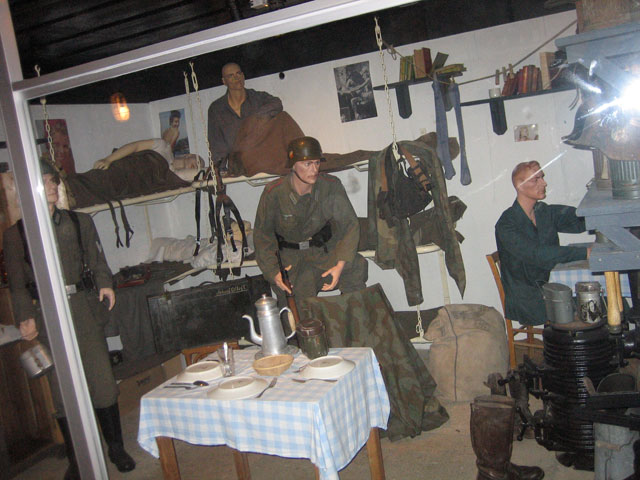
(Bunker exhibition.)
We stayed about an hour at the
battery and then went on to see our next point, the "Pegasus
Bridge". Just a quarter of an hour by car we found this
nice museum and the bridge next to it. The museum shows a lot
about the history of the invasion, the bridge and the involved
armys. Very nicely done. The bridge was a rather important part of
the invasion, control of the bridge allowed the allied
armies to move forward away from Sword beach and at the same time
confined german troop movements.

(The museums shape resembles a wing.
Nice idea...)

(The old Pegasusbridge.)
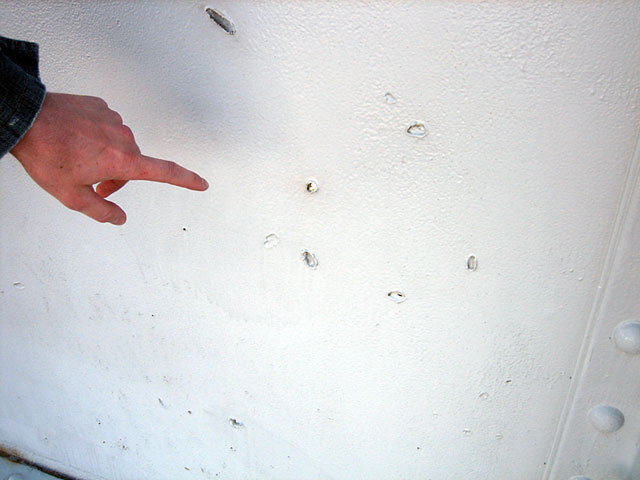
(Bulletholes on the bridge.)
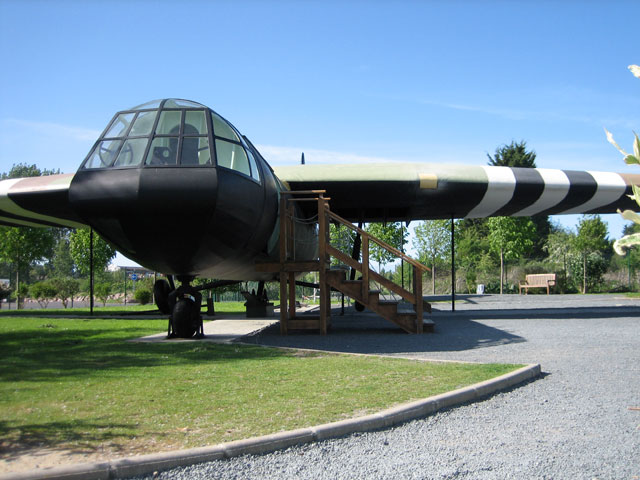
(A remodeled Horsa-Glider plane
which can't be accessed anymore unfortunately.)
We had a long look at the bridge,
the glider and the small exhibition in the barrracks in the back
part of the area that dealt with the equipment used to set up
pioneer bridges. Quite interesting, it was a rather weird feeling
to see this bridge in person. In movies like "The longest day"
it seems to be so large, but in reality it is rather small and
tiny. It had not at all the impression of being of any
significance - but it did. A nice exhibition in any regard and a
great start to our tour of Normandy.
Größere Kartenansicht
Again after an hour we had seen
everything there was and we skipped reading the rest of the
information that was given at the museum. We went to the camping
ground in Bayeux next to set up our night camp and finally have
some food.

(Camping in Bayeux, France.)
Once arrived there, I used whatever
french I could muster to reserve us our spot. Since we were there
right at the beginning of the season, there was plenty of room
left, the camping ground was sparsely populated and the neighbors
interested, yett somewhat reserved. Which was ok with us. The
sanitary conditions were... present. France. The bathrooms were
partially usable, but nothing more. Showers were simple, but
sufficient. And warm. All in all we would be ok for two days. In
any case this would be a rather cheap stay, only the temperatures
at night were troubling us. It went down to 7C at night, which was
very, very cold. Like last year BBQ and drink supplys were
excellently prepared, we had a pretty good dinner with steaks,
baguettes tomatoes and radishes, some cheese and sauces - pretty
good. Icecold beers were also quite welcome after such a long day.
But it soon got pretty cold, we started even burning the wax coats
of the cheese to get the fire to be a bit warmer, not effective
but certainkly fun! But despite being clothed in shirts, sweaters,
jackets and even a thermal blanket, we went in to the tent not too
late at night since it was just too cold to stay out much longer.
Größere Kartenansicht
Luckily a few days before our trip
the local supermarket had a sale on thermal blankets of which I
acquired a pair. I also brought a woolen blanket with us, so we
were able to accomodate us in the tent against the weather a bit.
One thermal blanket was on the ground insulating the air
mattresses from the bottom, one was on top of them to warm us from
below, the woolen blanket came on top of the sleeping bags. Looked
funny but kept us decently warm. Of course sleeping in a tent is
never as good as sleeping at home in a warm bed, but we were not
really here for a comfortable vacation...
|
|
|
|
Widerstandsnest 62 - Omaha
Beach
Morning came surprisingly early, the
sun began to rise and we hit the showers. Following a good breakfast
we went our way to see the main target for our journey: the beaches
of Omaha Beach and the german stromgpoint 62. It was a rather short
trip there, only a small detour thanks to a construction zone cost
us a few extra minutes of driving. Directly next to it is the giant
american cemetery that was featured in Savong provate Ryan, in the
opening scene. We were thinking about visiting it as well, but then
opted against that. A short while later we parked the car on the
small parking lot above the strongpoint and headed over to check it
out. It was an eerie feeling to visit this site in the early morning,
long before most tourists would come over to see it.
Größere Kartenansicht
The Strongpoint 62 was a
heavily defended and partially bunkered german strongpoint located
at the east end of the allied landing at Omaha during the second
world war. Its claim to fame is that it was the german strongpoint
costing the american assault the most lives on the day of Operation
Overlord.
WN 62 consisted of a 332 × 324 Metres
big area, which was located between 50 and 100m away from the coast
line. It was located about a kilometer north of Colleville-sur-Mer
on a 20 degree slope. The various defenses in the strongpoint
allowed for an excellent view on the beach and were between 10 and
50 metres hogher then the beach. It was located exactly between
sectors Easy Red and Fox Green.

(View of the area from above, in the
middle is a memorial for the dead. Barely noticable is a small
one-man-bunker, a so called "Tobruk" to the right of the
path. Zigzag lines on the ground are the remains of the trenches.)
Quite touched we checked out the
memorial first. The panoramic view across the beach may seem to look
normal at first, but we felt quite not normal then. On this confined
ground one of the worlds bloodiest batles was fought. And all that
is left of it are a few bunkers, memorials and the massive graveyard.
Without those, nobody would really expect something like this here.
Makes you feel rather insignificant and helpless compared to
nature.

(Unfortunately a slightly small
panoramic view of the beach at WN62.)
DThanks to my reading before I had a
pretty good idea what was left to see despite lacking a map. We
began with checking out a small infantry bunker that was used to
house the german soldiers. It is very close to the memorial. Such
simple group shelters were widespread at the atlantic wall.
Basically they are fortified earth dugouts with a concrete shell.
There are usually "Regelbauten" used at the atlantic
couast, but the stromgopints occasionally lacked those when they
were not done.
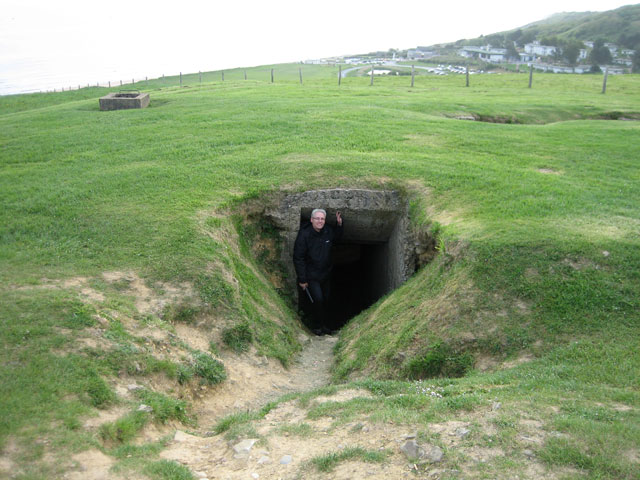
(On our way into the first bunker,
the group shelter at WN62.)
The ground inside the bunker was
filled with trash and in general it was in poor condition. Te
ceiling still featured rusting sheet metal reinforcements, the
emergency exit was already filled half with earth and someone tried
to dug a hole into one of the corners. I have no idea what they
thouoght to find there.

(Inside the Bunker, the rusty ceiling
is slowly coming down and there is a good amount of trash on the
ground.)
I took some pictures of the inside of the bunker, there was not too
much to see here anymore. Early in the morning it was still rather
quiet around, gave sort of an idea how it might have been before the
invasion started.
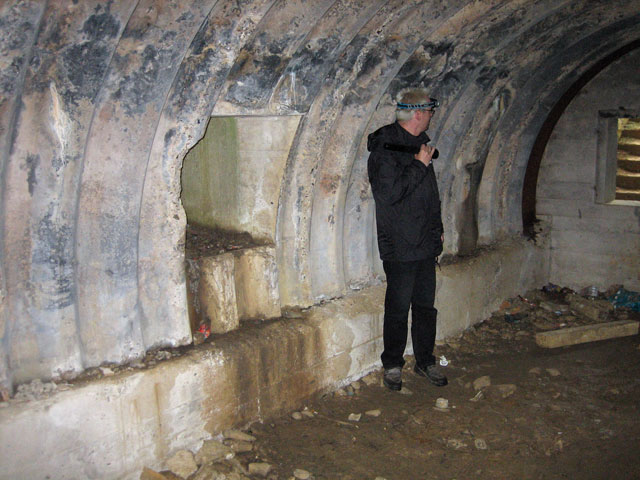
(Still in the Bunker, opposite side.
In the middel the emergency exit, in the background a guarding hole
to defend the bunker, pointing towards the small mortar bunker.) We
checked out the bunker for a while longer, but then decided to move
to the next object, the mortar bunker right behind the shelter. At
the time of the invasion it wasn't equipped yet with a mortar, so it
was used for other infantry weapons apparently. A very small object
which is half way filled with soil now, so entering it was a
difficult task.
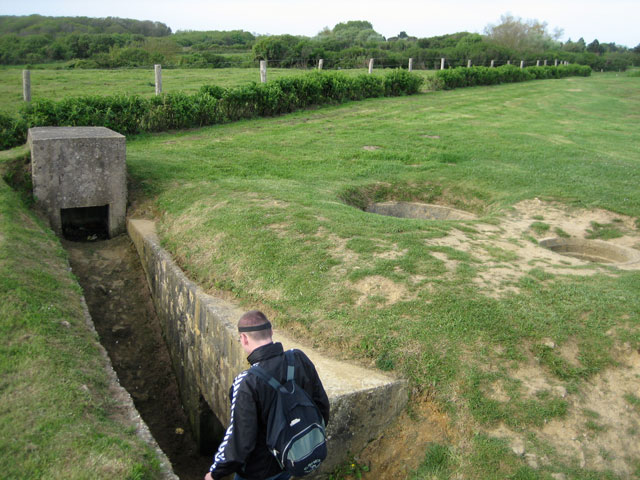
(On our way into the mortar bunker,
at the end is a communications post in the concrete slab. The trench
was made out of concrete here.)
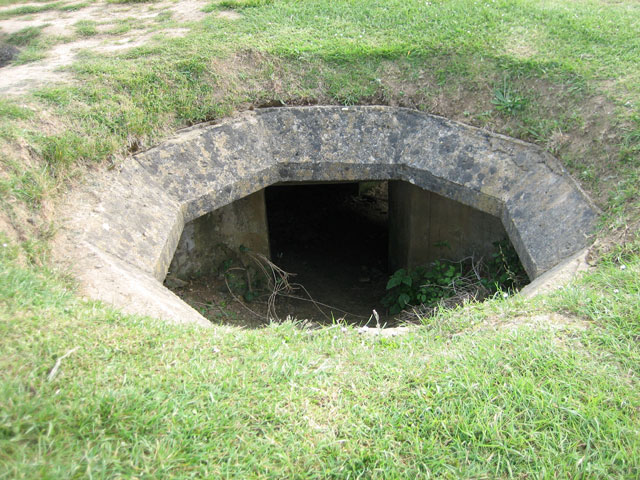
(View from the top inside the mortar
position, it is half filled with soil now. Difficult to enter.) From
there we went towards the beach passing the soil-filled Tobruk
bunkers. We arrived at the bigger gun casemates and saw huge scars
on the bunker from the battle. The bunkers were pretty good shot up.
The small bunkers had flanking guns mounted in them to not expose
the guns directly towards the sea. They were pointed in general
towards the Pointe-du-Hoc, direct defense was done using the smaller
Tobruk bunkers and filed positions with automatic weapons. There is
however pratically nothing left of the field positions, slilght
indentions in the ground is all that is left from it.
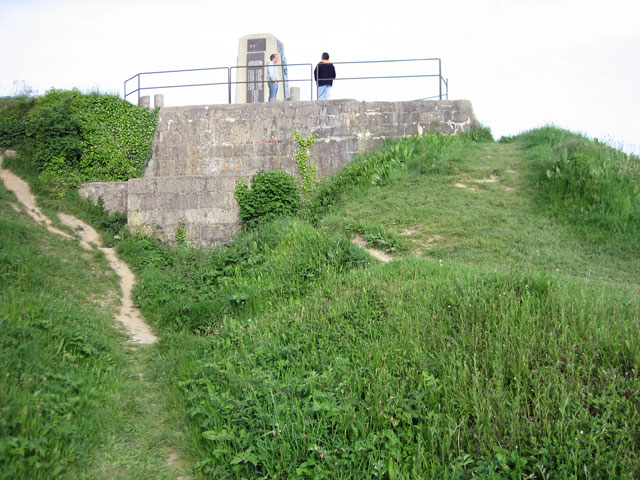
(Casematte from the back, the
concrete blocks at the entrance were fitted once the gun was placed
inside to increase protection.)
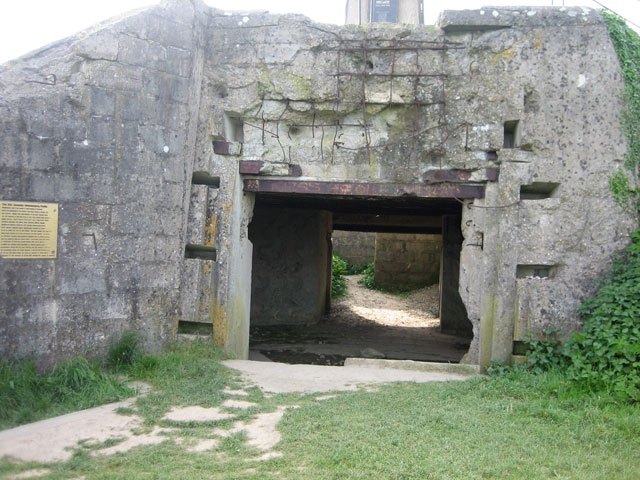
(Casematte from the front, the
armored shield has been taken out. Craters from the shelling on the
bunker are easy to see.)
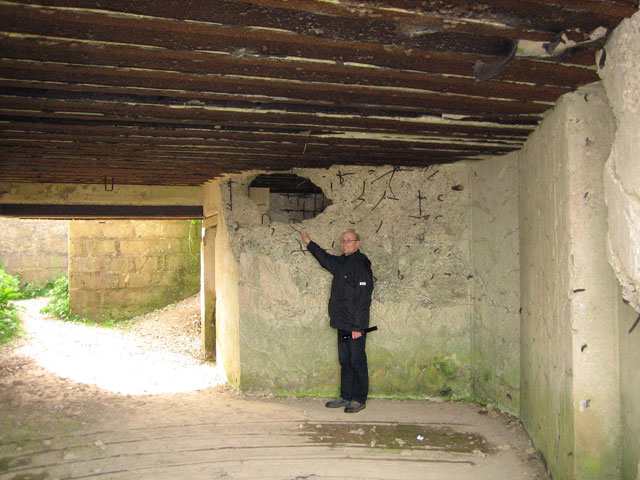
(The results of a direct hit on the
bunker - inches of steel reinforced concrete were simply gone,
nobody had a chance to survive that. In the background the entrance
with the concrete blocks. The round metal bars on the ground were
the tracks on which the gun was moved for targeting.) The
second bunker looked much like the first, also having been hit by a
lot of shells. We checked out the devastation the shleeing brought
on the bunkers and spent quite a while in them despite their
relatively small size. Unfortunately the second bunker filled up
with water partially, so we didn't enter it too completely. Due to
its small size that is not a propblem since you can easily walk
around it.
We went down to the beach itself then,
which was rather small since we arrived at the peak of the tide. On
the way down we met the first battlefield tourists, who arrived in a
tourbus from battlefieldtours from UK. What was intersting to see at
the lower parking lot were the remains of the tank ditch and the
small eartehn wall that was built there to trap attacking tanks.
Nowadays it is pretty shallow and in a few years it probably will be
gone completely.
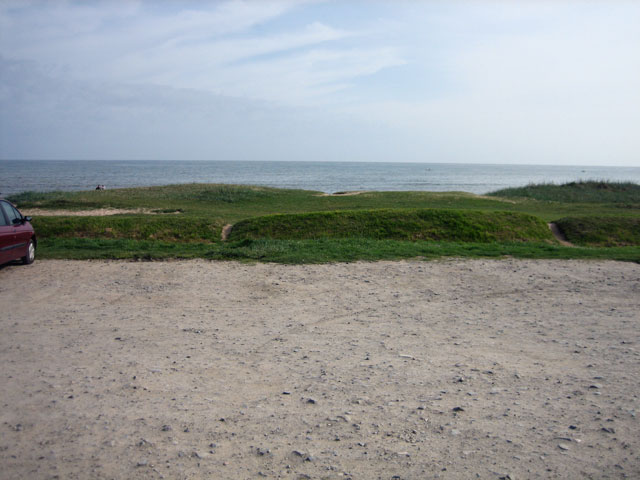
(Tank ditch and wall at the beach of
WN62 from behind. Notice, how flat the beach is here.) Viewed
from the beach, the slope of the hill didn't seem to be that stepp,
but in fact it is. Also easy to spot is the complete lack of any
cover on the beach except the small sandwall which is build up by
the tides. Not even as high as a person it was the only cover the
american solderis had from the german machineguns.

(Antitankditch and wall at the beach
viewed from the side.)
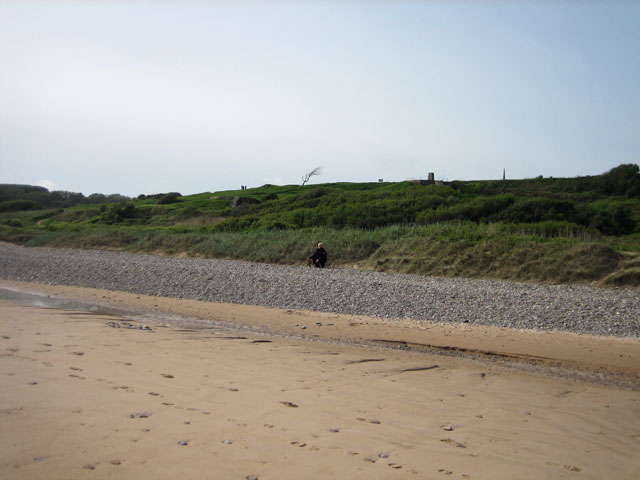
(Keeling in front of the sandwall,
the only cover at the beach. Up on the hill are the two bunkers of
the WN62.) We spent a little
time walking up and down the beach and climbed back up the slope of
the hill. On our way we passed a little campsite, someone did in the
bushes right behind the beach. Something idyllic - quite a change
from the usual things we see on our bunkertours...
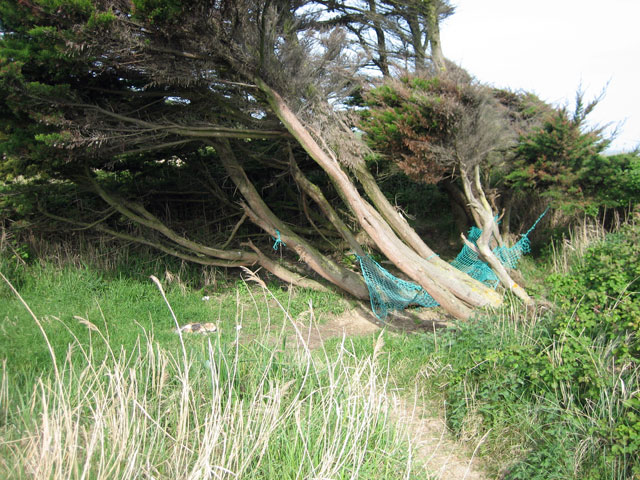
(Camping at the beach, with campfire
and hammock...) A little more
then an hour in total we spent here at the beach, then we went back
to our car. We planned more time for the visit, but there was (except
the cemetery but we ultimately passed on it) just nothing else to
see. Our next target would be one of the many museums in this area
that was supposed to have ome of the landing craft and interesting
equioment on display. Following
a surprisingly short ride later, we arrived at the Musée
D Day Omaha in Vierville-sur-Mer. Instead of the planned two hours
for checking it out, we managed to see everything in a good half an
hour. That is mainly due to its nature of a wild accumulation of
Militaria and scrap metal, disguised as a museum. The informaton
texts next to the exposition were someties completely of, the
marching music in he background really turned us off and the shown
equipment.... well the presentation was seriously lacking. On the
positive side we saw a bunch of interesting equipment, which will
excite a fan of games like Company of Heroes: There was a complete
Goliath mini RC tank on display. That was quite a sight.
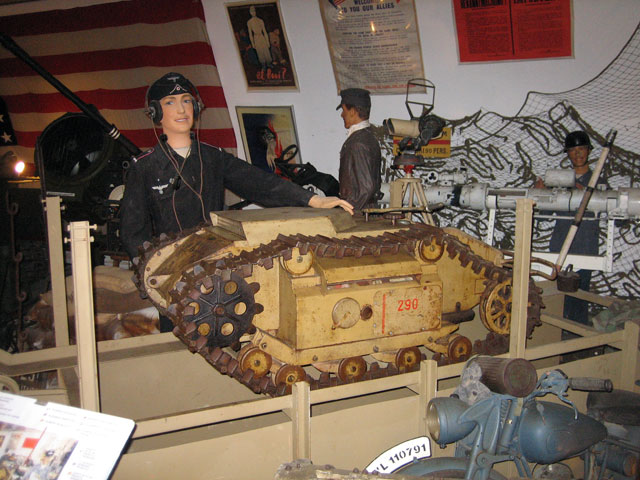
(Goliath with Transport box in mint
condition on display.) We were
not at all thrilled by the way the museum was set up and the
surroundings,but seeing those interesting items was in the end worth
it. Still: A museum of the category "see it once but never
return".

(Decaying landing crafts, scrap metal
and in the background a sanitary catastrophy: French public toilet.
An adventure by itself...) Outside
the museum we saw some more or less scrapworthy objects which might
or might not have anything to do with the D-Day. A czech gun from
the late 60ies...? Spectacular was an armored cloche at the entrance
of the museum, but we could'nt enter it. Pity. We
settled down for a small lunch and discovered that we forgot to
bring spoons and our pots for preparing the soup. We had the camping
burner with us, but without food it didn't really help. So we had
some snacks instead which lasted for a while. Planned
next was a visit at the battery Longues-sur-Mer, but taking into
account that we were so early done with our first two targets for
the day, we instead decided to visit our optional goal for the day,
seeing the museum Musée
Memorial d’Omaha Beach in Saint Laurent-sur-Mer. As it turned out
this was a good idea, this museum was well worth the visit. Also
equipped with interesting items, this museum had a much better way
to display its exhibition and showed artifacts in context and even
with correct information. Also an interesting movie was shown in the
theater, all in all a good experience. Thumbs up for this stop in
our journey!
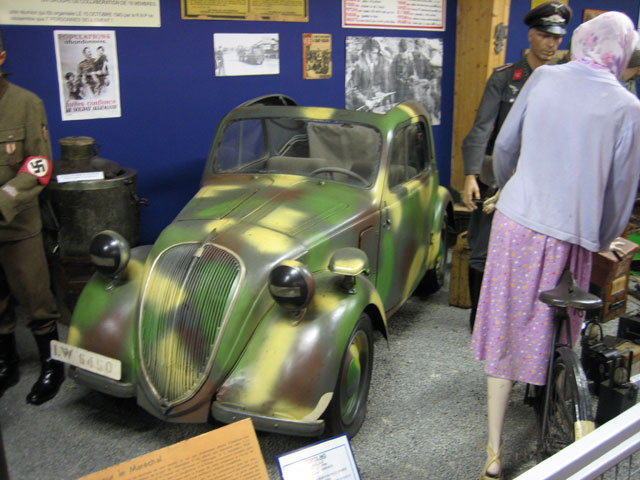
(A "Topolino" car, which
the Wehrmacht used during the french occupation.)
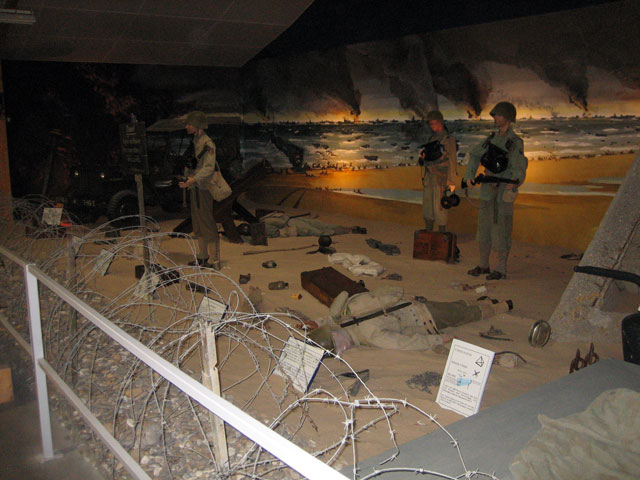
(Awesome dioramas and displays,
equipped with authentic items and labelled informative - this is how
a good museum looks like!)
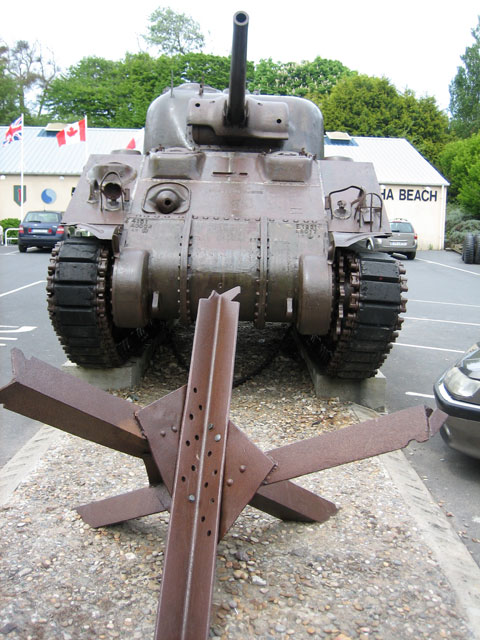
(In front of them useum was a well
kept Sherman tank behind a czech hedgehog-type tank barrier.) Our
plann was now to continue to the battery - we had yet another little
snack but then followed our GPS unit. Unfortunately it lead us into
a dead-end where we saw - yet another bunker. So we took the chance
and checked the bunker and its surroundings out as well.
Größere Kartenansicht Later
research lead me to believe that this was the strongpoint Widerstandsnests (WN65),
since a bit up the high we found a few traces of shelters and
trenches. My attempt to enter the almost completely disappeared
shelter didn't work out too well since I forgto to bring my "dirty
activity pants" and in the interest of not looking like a
complete tool the next two days, I refrained from trying to squeeze
through the small earhten opening. Judging by the picture this
wasn't the worst thing, it seems to be filled up with trash again.

(5cm Pak Gunbunker at WN65..) The
WN65 is mostly known for the small gun bunker which is now a
well-known tourist spot. It still has a 5cm PAK antitank gun in it,
of which we took quite some pictures.but even most descriptions
online only speak about this bunker, not about the shelter that we
discovered uphill. Semms like the shelter has been dug out again
rather recently... There should have been also two mortar Tobruk
bunkers, but we couldn't find those.
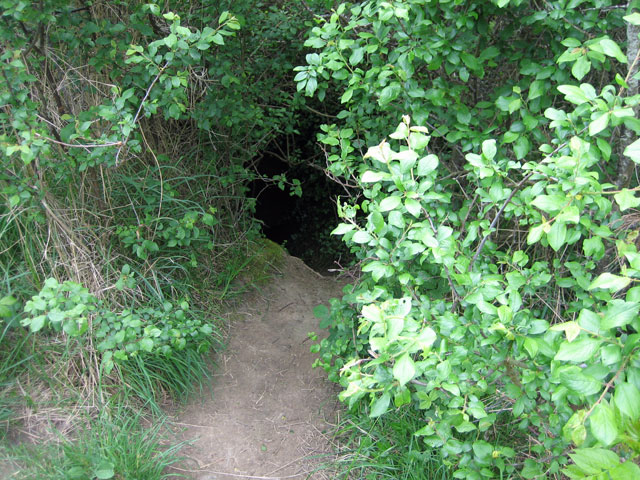
(The path to the mostly earth filled
shelter (?).)
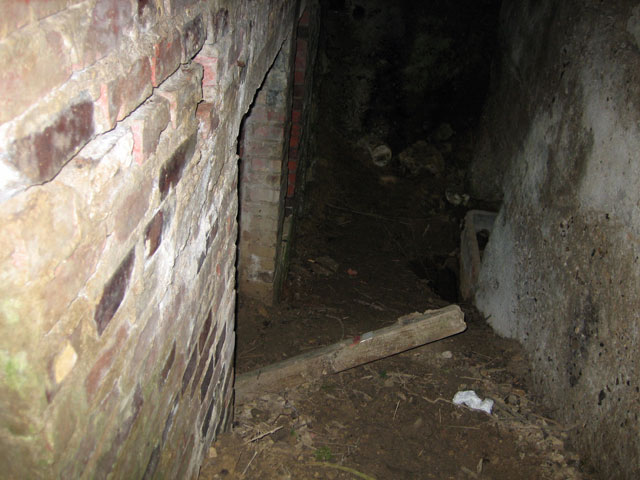
(Entrance of the shelter, not too
promising. Note the brick walls instead of concrete...)
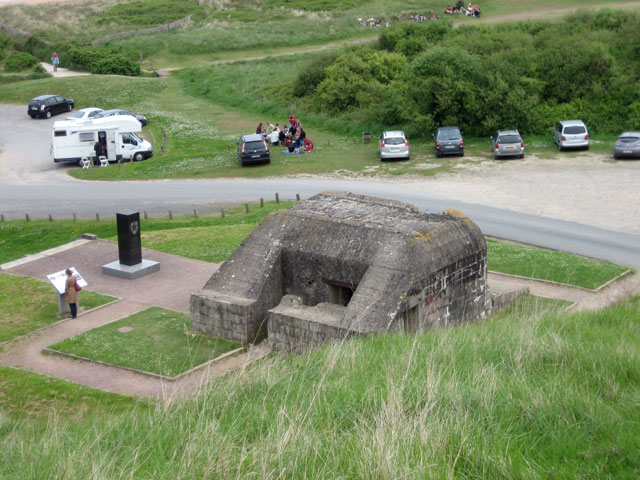
(View of the PAK bunker from behind.
The beach is barely visible in the top left corner.) Within
half an hour we were done checking everything out and decided we
would change plans about the rest of the day a bit. Since all our
visits so far were doine much faster then planned, we decided to
change our travel and visit Point du Hoc already, do St mere Eglise
and two batteries on theladt day and skip the museum in Bayeux. That
should also minimize our driving. And
that's what we did: We wen to the Battery
Longues sur Mer next and skipped the museum in Bayeux. A short
drive later we arrived at the battery, parked our car and went to
see the four massive gun bunkers there. Since this battery is not on
provate grounds, there is no admission fee to see them. That has its
ups and downs... The
Battery Longues sur Mer
is the only remaining german coastal artillery battery of the
atlantic wall with its guns intact in all of Normandy. Making it a
must-see target. It consist of four massive gun bunkers, the guns
and the bunkers vary in their degree of destruction. Some of them
are rather well in order, some almost runis. Most of the destruction
came from ship artiellery hitting the bunkers during the invasion.
The bunkers are about 2km away from the coast and are parallel to
it. For its crews some smaller bunkers had been installed in
shelters under the earth closeby the main bunkers. Not all of those
are made from poured conccrete, some are constructed using big
concrete slabs.
Its main armament were four 15-cm-rapid fire guns, besides that
there were some machine gun bunkers, mortars in Tobrukbunkers as
well as minefileds and of course barbed wire.
Größere Kartenansicht
Located
at the coastline are tow small Tobrukbunkers and the former
Surveillance and fire command bunker. The big bunker was used in the
movie "the longest day", but not in its original use.
There it was displayed as a command bunker, decorated with a
quadruple 2cm FLAK gun. These three bunkers were not accessible for
a long time, but in 2004 they were all excavated again and made
accessible to the public. And
making those accessible (and free) for the public is here a big
problem: We were constantly facing huge crowds of students which
were completely uninterested in this part of histroy. Even worse,
they kept chatting and texting each other (!) on their cellphones
all the time, while being only 10m apart. What the...? And the
absolute top of it all was the bunch of 9year old french boys that
literally pissed right next to us inside a bunker at a wall.
WHAT THE FUCK? Many
thanks for this impressive display of respect for the history and
the dead, dear country of culturally developed neighbors. That was a
great display of how to deal with both countrys past. We were
disgusted.
Too bad, the
battery itself is a great visit. make sure to visit it when no pesky
students are around.

(All bunkers in one shot.)
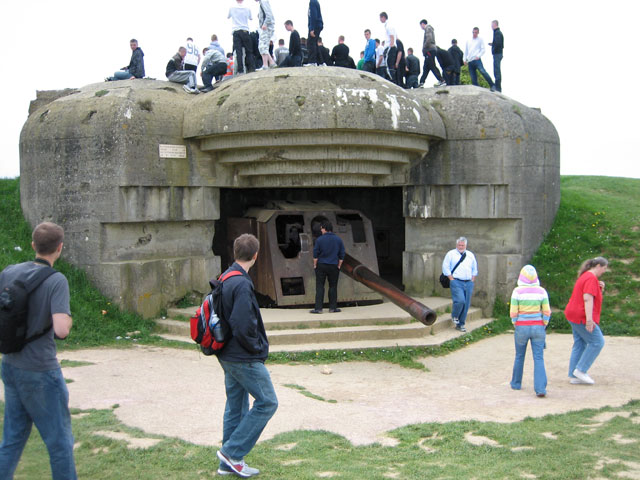
(Bunker with tons of students on top.)
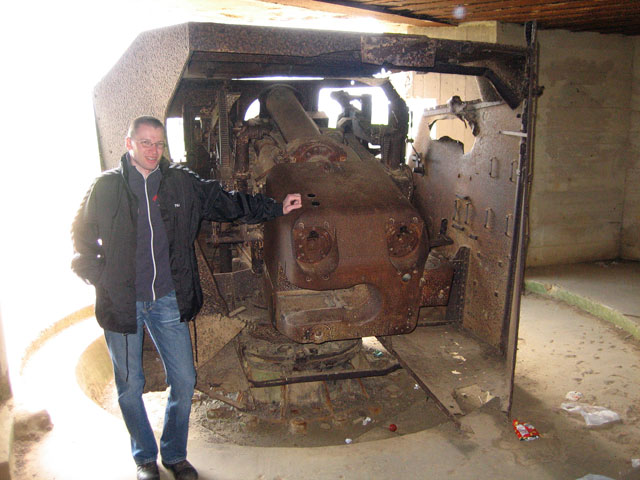
(Inside one of the bunkers with one
of the guns, Robert serving for scale.)
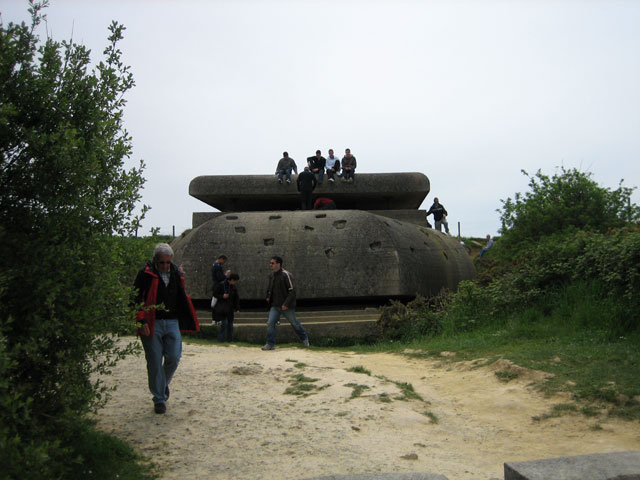
(The famous observation bunker.)
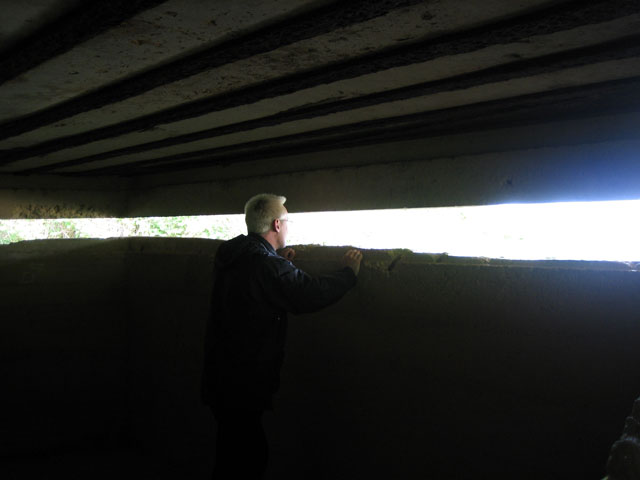
(Inside the Bunker.)

(Hole in the roof of one of the main
bunkers.) A refreshing walk
back to our car later we arrived at the completely overcrowded
parking lot, which was used as well as a camping ground, BBQ site
and - what else? - a public bathroom. Not too surprising anymore...
We decided upon the crowd to leave the premises as soon as possible
and head out to our next target of the day, the Point du Hoc. In
total the battery was well worth the visit, but visits should be
done in bad weather or in the early morning. The other tourists
really spoil the experience and they often lack any sort of tact,
respect or plain humbleness.
|
Point du Hoc
Originally we should have been by now on the road to the Musée Mémorial de la Bataille de Normandie
in Bayeux, but taking into account that we already saw two museums
that day, we opted to see the Point-du-Hoc instead. The drive
there took a little while and we had some sausages on the way to
it. All in all we were almost traveling for an hour, cutting a
little bit into our schedule. Arriving at the Point-du-Hoc I saw a
rather a familiar sight: Giant, overgrown craters created by the
massive air and sea bombardment bore witness of the huge
destruction and brutal fighting that took place here decades ago. Robert
hadn't seen craters of this size before while I was aware of them
due to my visits in Verdun and the Somme. Craters there are
usually smaller, but there are many of them. Here were less
craters by numbers, but they were all pretty huge.
Größere Kartenansicht
We went from the huge parking lot
to the tip of the Point du Hoc and saw many, many bunkers on our
way. The area is public ground and free of charge to visit. With
that of course there is a huge tourist crowd at this place all the
time, but at least people acted a bit more civilised here. No
peeing that we saw. So the really huge groups of toourists
probably keep the kids from misbehaving too much. A nice touch is
that the area is belongin to the USA now, so they keep it in
rather good condition.

(Crater at the beginning of the area.)
Pointe du Hoc is a clifftop location on the coast of Normandy in northern France. It lies 4 miles (6.4 km) west of Omaha Beach, and stands on 100 ft (30 m) tall cliffs overlooking the sea. It was a point of attack by the United States Army Ranger Assault Group during Operation Overlord in World War II.
The plan called for the three companies of Rangers to be landed by
sea at the foot of the cliffs, scale them using ropes, ladders,
and grapples under enemy fire, and engage the enemy at the top of
the cliff. This was to be carried out before the main landings. Despite initial setbacks because of weather and navigational problems, resulting in a 40-minute delay and loss of surprise, the cliffs were scaled and the strongpoint was assaulted successfully, with relatively light casualties. Fire support was provided during the attack by several nearby Allied destroyers and British LCS's[6]. Upon reaching the fortifications, most of the Rangers learned for the first time that the main objective of the assault, the artillery battery, had been moved out of position, possibly as a result of air attacks during the buildup to the
invasion.
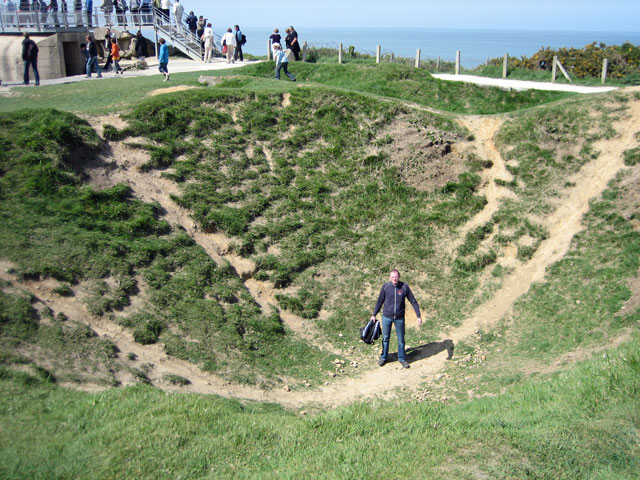
(Another huge crater next to the
cliff.)
The costliest part of the battle for the Rangers came after the cliff assault. Determined to hold the vital ground, yet isolated from other assault forces, they fended off several German counterattacks over the next two days, until reinforced from Omaha Beach. The original plans called for an additional, larger Ranger force of eight companies to follow the first attack, if successful. Flares from the clifftops were to signal this second wave to join the attack, but because of the delayed landing, the signal came too late, and the other Rangers, mostly of the U.S. 5th Ranger Battalion, landed on Omaha instead of Pointe du Hoc.
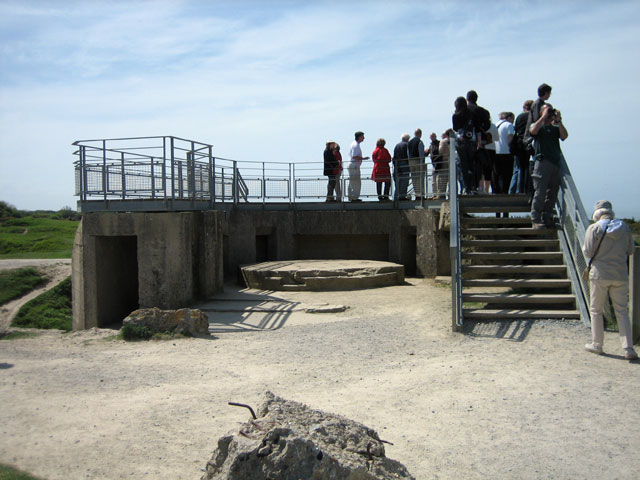
(Open gun platform with small
bunker built around itt providing protection from splinters and
shells. Used as an outlook platform today with a handrail on top
of it.)
We walked for a pretty long while
through this rather large site. Some parts of it were inhorrible
condition while others looked still very much intact and in rather
good shape. There were bunkers galore - we were shocked to see how
many small or medium bunkers were spread out in the site. The
further away we got from the entrance area, the less tourists were
to be seen and seeing the bunkers got more interesting. FInally we
found some
Regelbauten, where parts of the interior were still in them.

(Blown up ammo bunker.)

(Open bedding for one of the big
guns. These whould have been moved into the bunkers, but were
instead removed from the site altogether prior to the attack. )
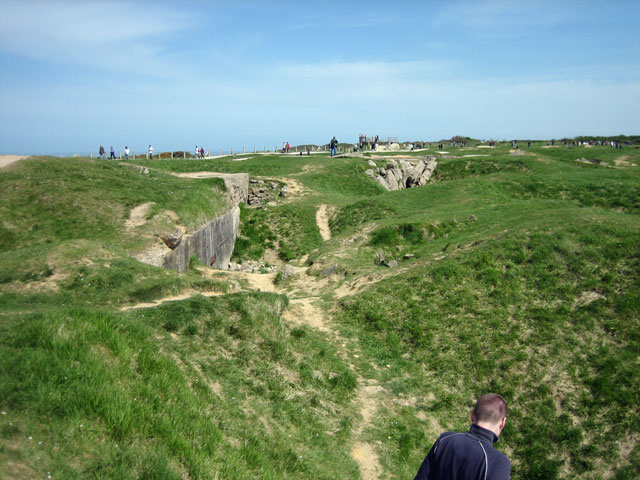
(Bunker next to bunker, the
landscape is dotted with Regelbauten. Notice how the artillery
caused shellhole next to shellhole.)
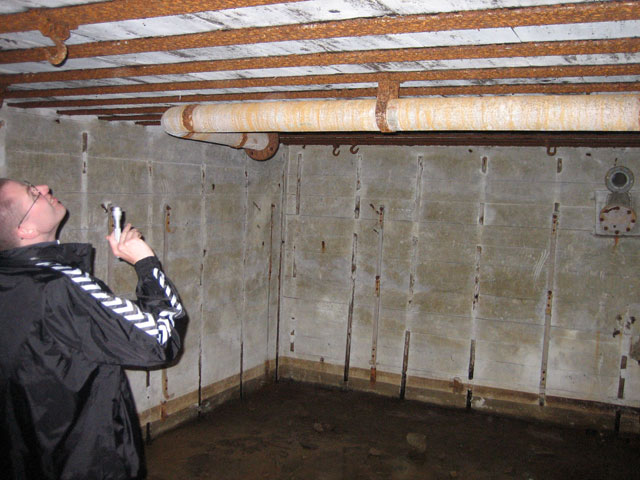
(Inside one of the Regelbauten. On
the ceiling are still traces of wood paneling, used for minimzing
splinters coming off the concrete when being shelled. There are
also still the hooks for the folding beds on the ceiling.)
We were pleasently surprised to
find tow or three bunkers in this touristovercrowded area that
were not completely plundered by trophy hunters and where we could
see still attached hooks etc. Probably because they are located at
the far end of the area and full of mud. Not inviting to the
casual, ill-equipped visitor, but for us this was no problem. So
when we left this bunker a few french kids started to climb into
them and of course got stuck in the mud, and left right away
cursing their fate... Not a smart idea to go into old bunkers with
sneakers!

(The famous rock needle of Point
du Hoc.)
We kept exploring the site for a
while longer, but at some point we had enough. Taking a few
pictures we made our way back to the car since we wanted to see
one more site that day: The Battery Maisy. Had some water at the
car and then drove the short way to the battery. The GPS uni once
again prvoed to be a very valuable addition to our journey, we
found the way thanks to it in record time.
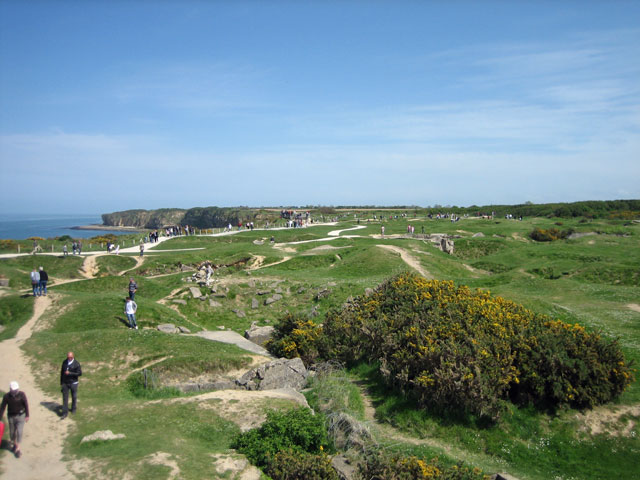
(Overview of the Point
du Hoc site.)
Battery Maisy
Less then half an hour later, we
were at our final place for the day, Battery Maisy. For decades
the site was vanished and buried under the soil and some even
claimed it never existed. However some british guy bought the
property where it was located and started digging the site out
again, turning it into a tourist attraction. There is still a lot
to do with the site, but so far what he accomplished with little
help is quite a sight. Occasionally restauration is a bit "rustic",
but it seems to be getting there. The owners do have a lot of
charme and are quite friendly. It was a real pleasure chatting
with them.
Größere Kartenansicht
Since the site is still largely
unknown to many, you'll encounter few tourists here. While we were
there, only 5 or 6 other tourists shoed up, which was quite nice
for us.
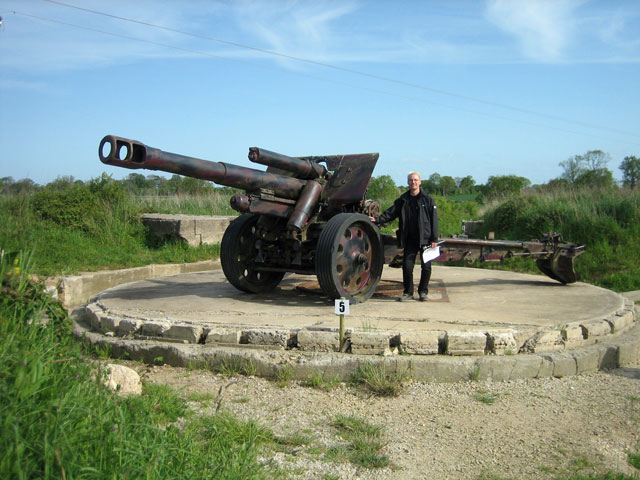
(Czech gun of the same type as it was
used here during the invasion.)
It was very interesting to see how
such a site looks just fter it has been dug out again, basically
this was "archeology in progress". Really exciting! Way
more down to earht (or actually in it) then the museums of course.
During our visit, which spanned about an hour we saw a bunch of
Regelbauten but also some more special buildings. Namely a radio
bunker, the foundations of a radar site bunker (this was claimed
by the owner) and a hospital. The eerie atmosphere of the site is
dominated by havong to use trenches all the time to navigate
throuogh it, since the walkways follwo the old trenches in design.
To get from one bunker to the other you follow those old trenches,
which is a bit confusing but gives a good impression, on how it
must have been back then at the site.
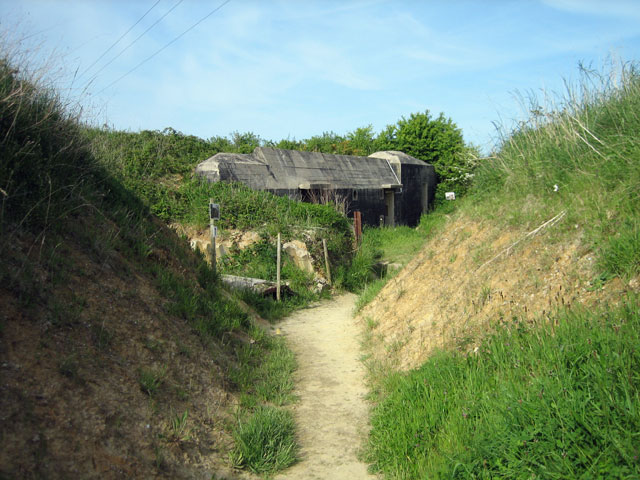
(On our way to a Regelbau bunker,
notice the trench you have to walk through.)
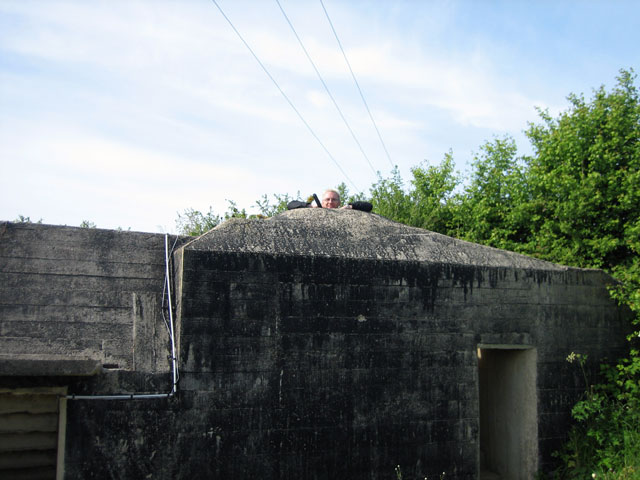
(The Regelbau has a Tobruk bunker
attached to it - there is still the black tar insulation and
waterrepellent paint on the bunker.)
Quite interesting was that part of
the site was set up underground, not just using the bunkers and
trenches. The main ammo depot was dug in underground and was
accessible through two longish tunnels. We saw something similar
later in Azeville, but so far I had not seen such a thing in any
WW2 installation since the Maginotline.

(Inside the long tunnels to the Ammo
depot. Power went out, so we relied onour flashlights, much to the
pleasure of the owner who was happy to welcome well prepared
tourists for once...)
Even a hospital had been set up at
the site, however most of that is gone by now. Only some metal
sheets of the roofs were left and the foundations. Quite
surprising is the "radar bunker", that the owner claimos
was about to be finished at the site before the invasion. I still
think it looks as if they were jsut starting to build it, since
only the foundation and some reinforcment can be seen. It was
apparently supposed to guide AA and normal artillery.
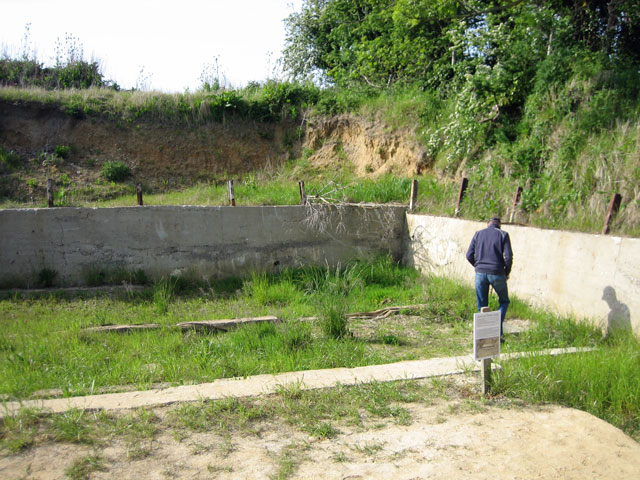
(Remains of the Radarbunker - on
the edges there are steel bars. Looks very unfinished.)
Next to the radar bunker was a
minor hill which we climed to get a good view over the whle site.
It is very difficult to get an idea, where you are without
climbing up higher dure to the trench system. A unique and
interesting way though to present such a site.
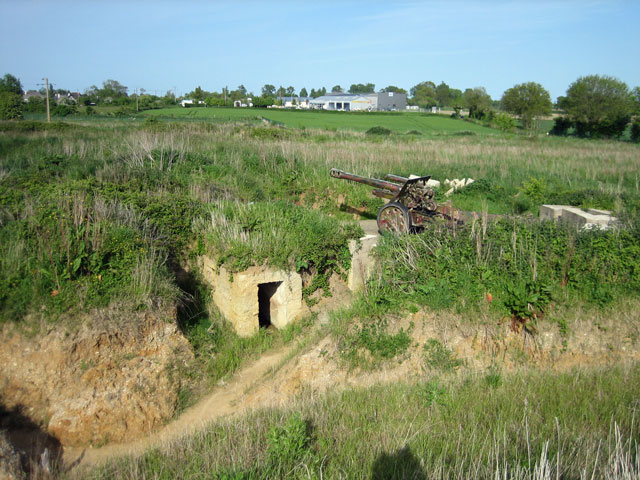
(A small overview over the site.)
We went towards the exit then, at
the moment more of the site is being dug out so coming back in a
few years might be interesting. There is still a third of the site
buried in the soil. We were definitely happy to have seen this
battery, even though there is not that much to see, it is a very
good way to present it and it has a certain uniqueness to it, that
made it worth the visit. Thumbs up.

(Picture of us on a landing craft,
nice gesture that we were permitted on it and have our picture
taken in it. No other museum allowed that!)
We said good-bye to the owners and
went back to the camping ground next, stoppping for some supplies
at the local supermarche. Following that we sat down in our chairs,
exhausted from the day we spent. So we BBQed again, had a few
chilled beers, and at a later hour we fought against the cold
again by burning everything that we could spare in the fire pit.
Didn't help very much though, so we went into the tent and wrapped
us in the thermal blankets under and above our sleeping bags. We
even managed to sleep quite a bit.
Early in the morning natures call
was a bit more pressing then usual for me, I was hoping that the
BBQ was not at fault... maybe the small sausages of which I
probably ate way too much. Regardless, I had no further problems
afterwrds. So we took a warm shower and packed up the tent (which
turned out to be too wet, so next time I need to bring a towel to
dry it prior to packing up!), said good-bye to the camping site
and paid our fee. Afterwards we headed out to St. mere Eglise to
see the targets for our final day there. Follwing that we would
have a long journey back ahead of us..
|
|
|
|
St. Mere Eglise
The last day of our tour came and we
were en route to see St. Mere Eglise and two more batteries in the
area before going back to Germany. First we went up north to the
small town of St. Mere Eglise, which we know mostly (besides
from movies) from a level of Call of Duty. Errrrr.... yes.
Early in the morning of the D-Day
allied paratroopers, 14.000 Americans of the 82nd paratropper
division landed in that are to support Operation Overlord in the
back areas od th Utah beaches by taking the city and its
surroundings. The taking over was indeed done by the 82nd, however a
lot of 101st paratroopers took part in it as well due to them being
spread out all over the place.
Größere Kartenansicht
Most famous was the mishap pf John Steele, one of the praratroppers
who got stuck on a church tower inthe town centre with his chute.
Sinc ehe could not free himself he was stuck in the middle of a fire
fight going on around the church. Seeing this church and a rather
new paratropper museum wouuld be our main things to do in St. mere
Eglise. In both cases we were not disappointed.

(The church tower with its
regularly renewd parachute dangling from it.)
Following a not too long ride we made
our way to St. Mere Eglise, parked our car on the lot in front of
the church and had a look at it. Turned out, that there was not that
much to see, we could take a picture of the parachute dangling down
from the church, since inside a church service was in progress. The
stroes surrounding the church lot were extremely touristy and we
decided to just stroll around for a quick glance. Selling militray
toys for kids and all kinds of expensive militaria for the "slightly
older kids" didn't really appeal to us, so we didn't buy
anything. We took a few more pictures but then settled on walking
over to the museum, which was really closeby. And that museum was
really great, very well done in setup, layout and exhibited items:
We were thoroughly impressed. Unfortunatley our pictures don't do it
justice, it was pretty hard to take pictures inside of it due to the
size and scale of things.
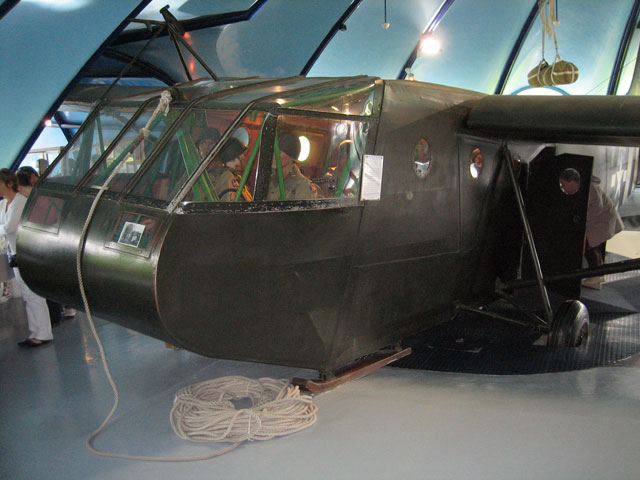
(US paratroopers glider plane in
excellent condition.)
To preserve this glider in its
surprisingly good condition, they recently build a huge dome
structure and filled the side of it with nice little items from that
era as well as informational tables and other stuff. Really well set
up.
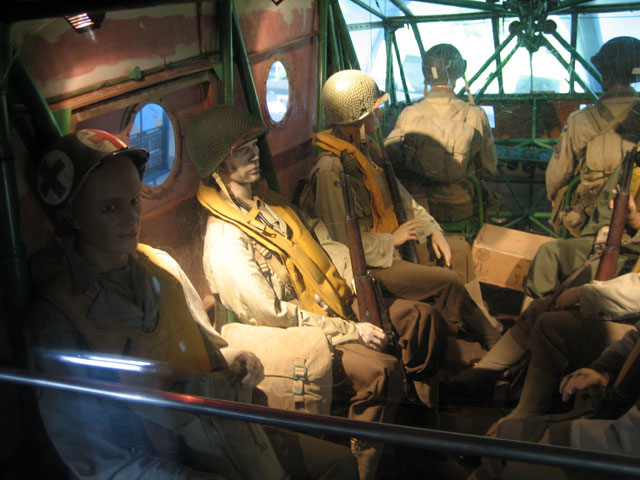
(In sie of the glider, everything set up
with lots of detail. Scary, how paperthin the walls of the glider
were - a complete death trap.)
We spent quite some time in the dome,
checking out the glider and the rest of the exhibition. After that
we went over to the other building, corssing the patio in front with
a Sherman tank and some field guns. INteresting to see, but not
really new. The central element on the second building is a compete
C47 plane, dominating the whoe exhibition. Again the walls were
filled with military and civilian gear and items from that era, but
also infomration tables were spread out all over the place, leaving
not many questions open. We really liked the setup and design of the
museum, very well done. It was a bit sad that the C47 can not be
seen from the inside, unlike the DC3 we saw on the first day, but in
contrast this machine was well kept and looked as if it was still in
flying condition.
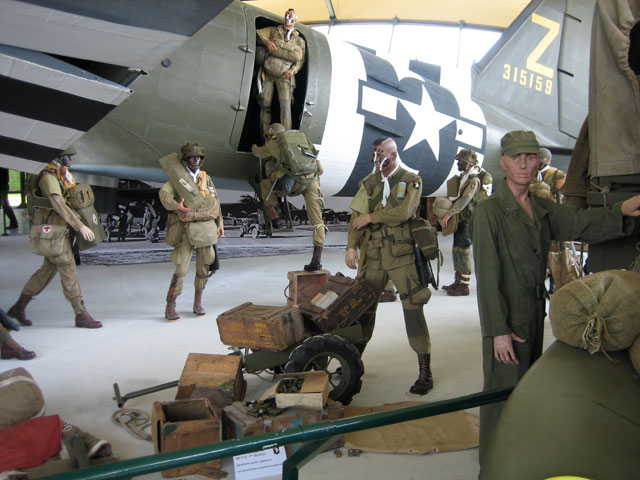
(Detailed scene around the plane.)
We criceld the plane, taking a lot of pictures. In my case in case I
want to build a model plane according to a historic plane, just in
case... my new hobby of flying RC planes came a bit through here. It
was astonishing to see how many US veterans were present that day,
as much as at Point du Hoc. Seemes like the paratroppers museum is
one of the main attractions, that US tours go to. Maybe even some
sort od standard trip they offer and that connects all those
interesting places which are easy to access and free of charge in
one big field trip. I'll look into that at some point.

(Details of the plane.)

(The second building of the Museum we
were really impressed by it.)
We hit the bathrooms leaving the museum in favor of the sometimes
dubious ones we saw earlier (turned out they were alright here) and
checked out the museum stroe on our way out. This was clearly geared
towards the US vet crowd, selling "Support
the Troops" T-Shirts and other some such devotinal articels
that did not appeal to much to us. So we just left and tracked down
some food nearby. We settled on the english Bistro a few houses down
the road, which was our tourist rap of the day. Figuring out that at
some point during a vacation you have to endure that kind of thing
happening, we figured this would be an ok place to get bent... Food
turned out to be OK, but 15 Euros for two rather medium sized
sandwiches and small coffees? Oh well. We were hungry. And out of
food/breakfast stuff, so we had to make do.
A few minutes later we left and
headed for the battery of Azeville, which turned out to be a great
experience, seeing a rather well preserved battery and its bunkers.
|
|
|
| Battery
Azeville
The semi final goal of our trip
would be the battery of Azeville, reportedly in excellent
condifion and recently restored to a pretty good degree. I had
read beforehand that it was renovated and that its museum part was
rather well done.
Something we can completely agrre
on. This battery was our favorite in regard to its presentation.
The guns are not in place anymore, but the bunkers are in good
shape and the rest of the battery is in a rather good condition as
well. Well worth a visit.
Größere Kartenansicht
We were most impressed by the
camouflage that is still painted to the bunkers. They were
disguised as castle ruins of normandy! Complete with painted on
balconys, hedges, trees and windows - even the sky and some clouds
had been put on the bunkers. I have never before seen such a
military Tromp l'oeuil. We began our tour in the first bunker
which is nowadays sporting a visitors centre. Equipped with some
MP3-players as audio guides, we then walked down into a
subterranean tunnel. Those tunnels connect the bunkers with the
rest iof the battery, as well as some Regelbauten. Azeville is a
good example, on how the batterys at the Altantic wall would have
looked like, once they would have been mostly finished. So we went
our way to see the tunnels and smaller bunkers before seeing the
big gun bunkers.
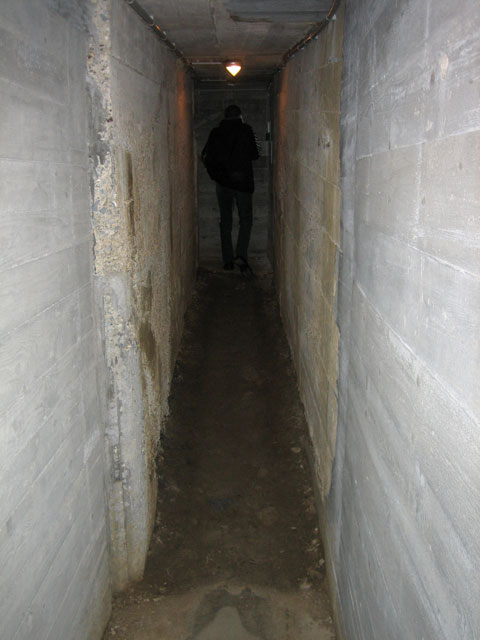
(Tunnel at Battery Azeville. In front
is newly poured concrete, but the concrete in the back is original.)
The tunnel system was already quite
interesting - I was reminded of the forts of Verdun, the Ostwall -
Robert was also amazed by them. This was something much more
complex then most of the other complexes we had seen on our trip
so far. Presentationwise it was so well done, Azeville was our
favorite of the batterys we had visited. Even though the guns are
not there anymore, it is still very worth visiting it.
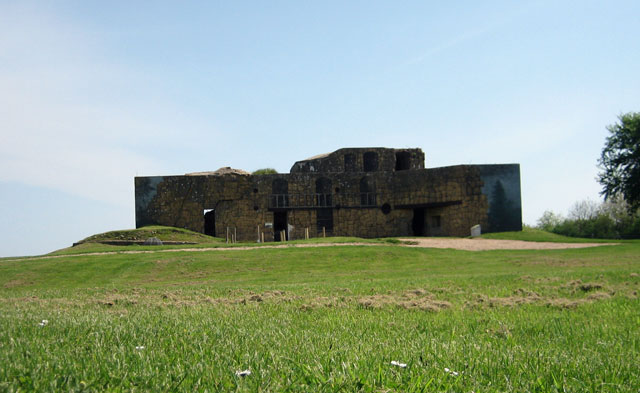
(Gunbunker with camouflage.)
It took us quite a while to check
out the entire tunnel system beofre being able to see most (not
all) of the gun bunkers. The first made a huge impression on us,
we saw the tracks of a huge grenade going through the bunker that
was fired from one of the US ships at the invasion. During the
landing the ships were shelling the battery and one of them
managed to hit the bunker directly. The grenade did not explode
though, it went through the armor plate in front of the bunker,
through the concrete wall between crews quarters and the gun
embracement and out the crew quarters again to finally lodge
itself into the ground somewhere inside the compound..
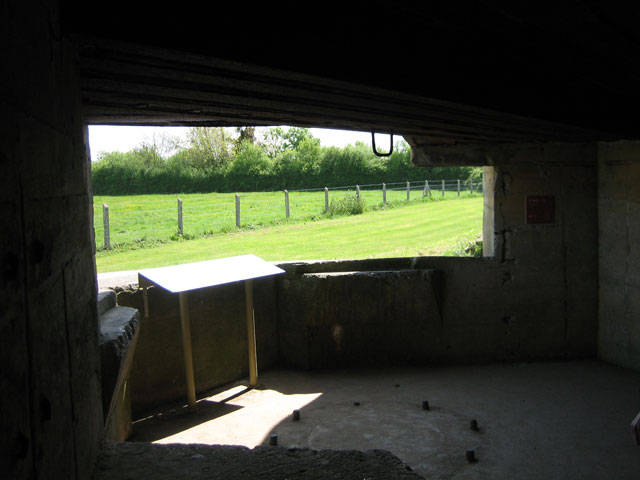
(Gun embracement.)
Due to the enormous pressure and
shockwave, this killed the whole crew instantly unfortunately. The
grenade never blew up and was finally recovered a few years ago
and is now on display nearby. This direct hit among the other
infantry attacks on the battery forced its crew to give it up a
few days after the invasion.
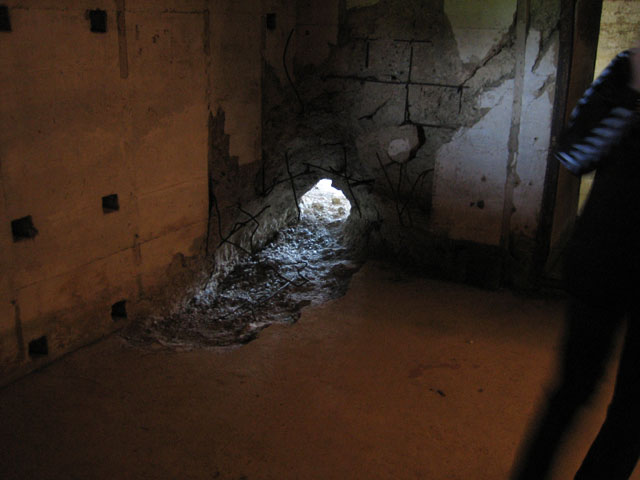
(Hole in the bunker wall from the
unexploded grenade.)
With the other bunkers we saw what
was left of them and inside of them, but there was not too much
new stuff to see. It got really repetative to us at this point.
Presentation of the items though was really well done.
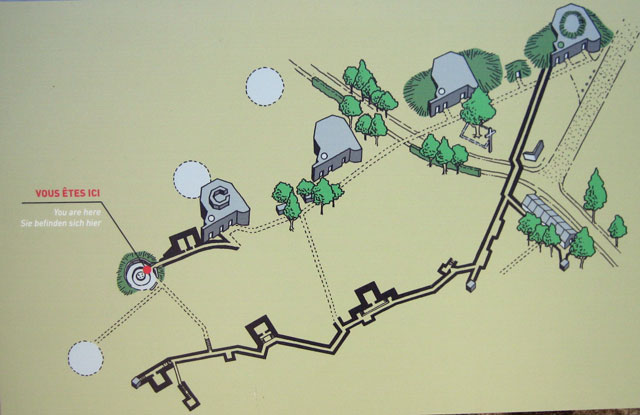
(Plan of the battery.)
At the end of our trip, we went to
see the foundations of the batterys casino and could listen to an
interesting story on our audioguide. It mentioned aspecially how
the civil population kept up with the bunkers and its occupants a
well as some of the more dubious parts of soldiers life here. The
audio guide mentioned that the local population was forced to work
for the battery, but was well treated. And that "dancing
artists" were brought in from Paris to entertain the german
troops. Ah - yes. Quite fascinating story there, we did not hear
anything like this at other parts of our trip.
A bit more then an hour in total
were spent at the site, but the audio guide would offer twice the
time to spend there provided one would want to hear all the parts
and stories. We did not want to spend taht much time here though,
since we still had the Marcouf battery on our plan. So we returned
the audio gear, watched the short (really good) movie that the
museum was playing in the first bunker (recommended to watch it)
and then went our way to the Battery Marcouf-Crisbecq. Not too far
away, but still another target to visit.
|
|
|
|
Battery Marcouf-Crisbecq
Teh naval artillery battery Crisbecq
is a german gun battery that is located nearby Saint-Marcouf, only a
few kilometres away from the beaches of Utah Beach.
The installation covers an area of about 4 ha, is elevated above the
surroundings and had a perfect view to the sector of Saint Vaast la Hougue
and to up to Pointe du Hoc. It wasconstructed at the beginning of 1942
by the Organisation Todt and was still under construction at the
time of invasion. Its 21-cm Škoda-long barreled guns were able to
cover a rather large area of rthe atlantic wall. Among the
installations were also a few 155-mm guns, anti-aircraft artillery,
grenade launchers and machinegun posts. It was in the 80km stretch
of the invasion beach the strongest installation of its kind.
American troops of the 4th infantry division that landed at Utah
Beach attacked the battery several times between 6. and 12. June 1944.
The battery crew under their commanding office Walter Ohmsen was
able to repel the attacks for several days, finally leaving the
installation in the night of the 12th of june. Of its 406 defenders,
only 78 survived.
Größere Kartenansicht
You can't always be lucky hen you go
hunting for bunkers, and in this case that proved to be true. The
Battery of Crisbecq was not the best end to our bunker tour 2009.
Still in awe from the great museum in Azeville and St mere Eglise,
we arrived at Crsibecq. And what we expereinced here was a wild
mixture of old and new stuff, museum parts, military surplus and
scrap metal and even Ikea-furniture. No kidding.
Seriously - a rollercoaster of an
experience to see this battery. The site is by itslef pretty
interesting and large. However the setup to visit is dubious at best
in most cases. And not cheap. We began our tour with the handed out
copied leaflet in something resembling german. Or dutch. It was good
that I had prior knwoledge about the battery because the
informational tables there were either not existant (for the most
part), wrong or just plain off. That was not so very good...
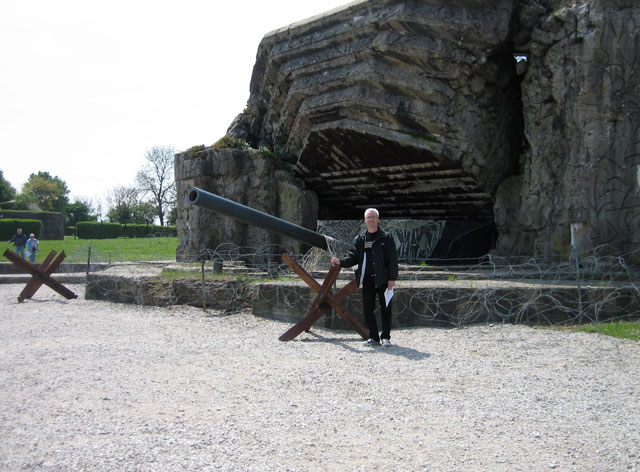
(Blown up gun bunker with gun imitation.)
The first bunker that we could
actually enter, caused us much entertainment - we knew that some of
the bunkers had wooden ceilings to protect from splinters. However
nobody told us, this had looked like an Ikea catalogue picture...
and the wooden beds were certainly never installed like that. They
were metal and folding and... oh well.
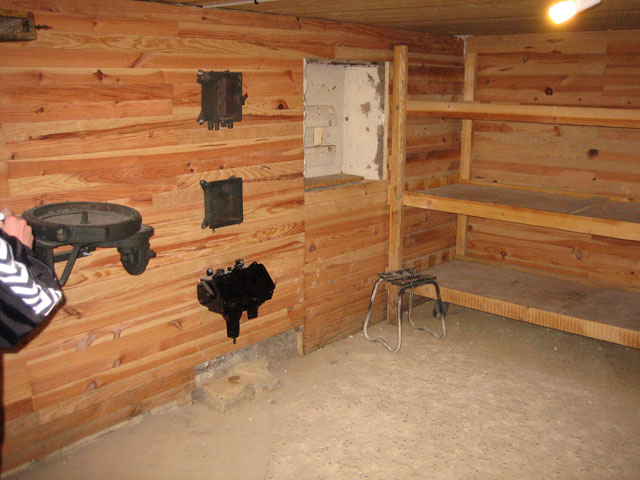
(Wooden paneling, not really authentic.
Seriously, not really.)
The rest of the walking tour brought
not much new stuff to see for us, we knew already from Azeville, Maisy
and Merville, how the batterys were set up, how the bunkers between
them looked like, and what in general is left of those batterys. So
it would not be fair to say we didn't see anything new, but what we
saw was more a military surplus collection disguised as a museum.
Pretty much like that one bad museum we saw at the beginning of the
second day.
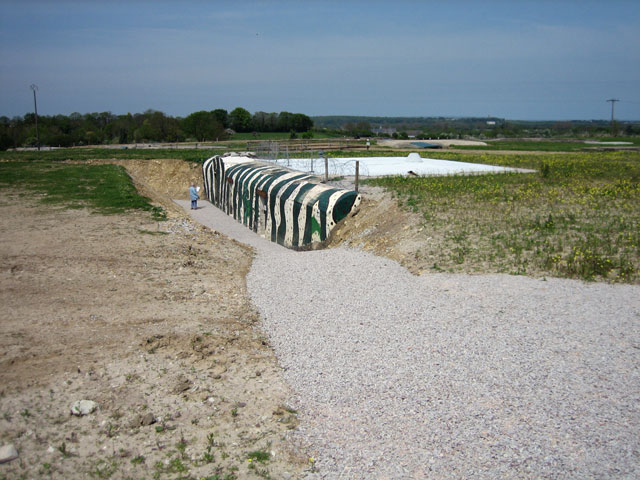
(Well kept Regelbau with obviously not
authentic "camouflage" paint.)
Regarding the obvioulsy wrong
reconstructions that were done - we thinkkt that the owner of the
compund changed recently and that the new owner has its own ideas on
how to attract new visitors by using more basic, cheaper and not
really authentic methods on reconstructing the site further. Whcihc
sucks for everyone who wants to see authentic things and not see a
Disney-fied version of a gun battery. On the other hand there were
some really exciting things to see, traces of the battle in 1944,
when the gun battery was taken by US forces for example. So a visit
might be worth it all things considered.

(Entrance to a Regelbau, blown up by an
explosion.)
To see the whole installation, it
takes about an hour. Due to the lack of written tables or other
information on the site, this can of course be done in much less
time. On the plus side, 21 bunkers in total will take quite a while
to check out, even though the number incluse tiny Tobruk bunkers as
well.
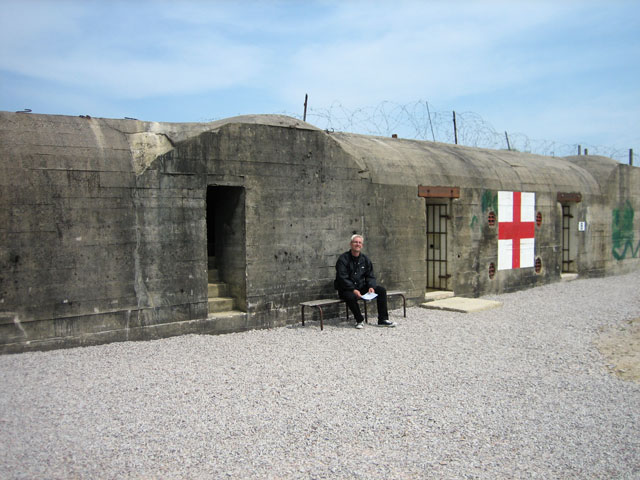
(Resting in front of a hospital bunker.)

(A field gun emplacement.)
Unique woth those round field gun
emplacements is, that the big guns were first placed here, like in
Maisy. But on the walls were written citaynames a codes for
targeting the guns. Neat idea. We haven't seen that anywhere else.
A little less then an hour later we
were done checking out the site, taking a bunch of pictures and
finally returning the coped note to the front desk. We then crossed
the small street to check out the other big bunker that is outside
the compound in the middle of a cow herd... The bunker was
unfortunately completely blown up, so there was not much to see.
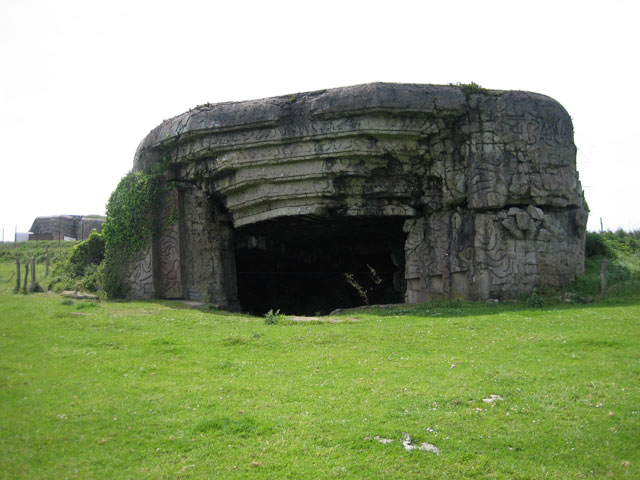
(The bunker outside of the main battery
area.)
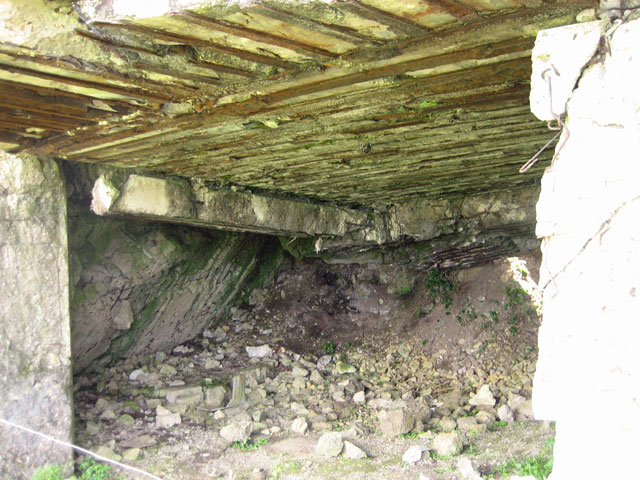
(Inside completely destroyed.)
And so as the very last bunker for
our tour, we checked out the small observation bunker opposite the
parking lot, that resembled the bunker in Longues-sur-Mer alot.

(Small observation bunker outside the
main battery opposite the parking lot.)
We went all around it and saw, that a
third of it was broken due to a massive explosion in it. And that
the bunkers entrances seemed to have been fenced over - however the
left entrance was not really fenced off well, - so we squeezed
through the hole and entered the bunker. It turned out to be much
more interesting then the other bun kers we saw during the tour of
the compound. It was all full of trash and brokoen glass and in
general full of debris, but it was still pretty fascinating.
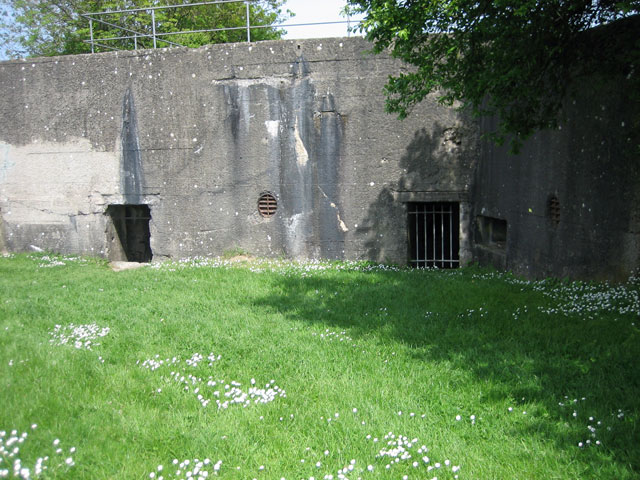
(Normally fenced off to the public - the
left barrier is not quite closed anymore...)
We took a few pictures while walking
through the bunker using our flashlights. The lower level of the
bunker is completely filled with soil and other parts of the bunker
caved in, so we could not see all of it.
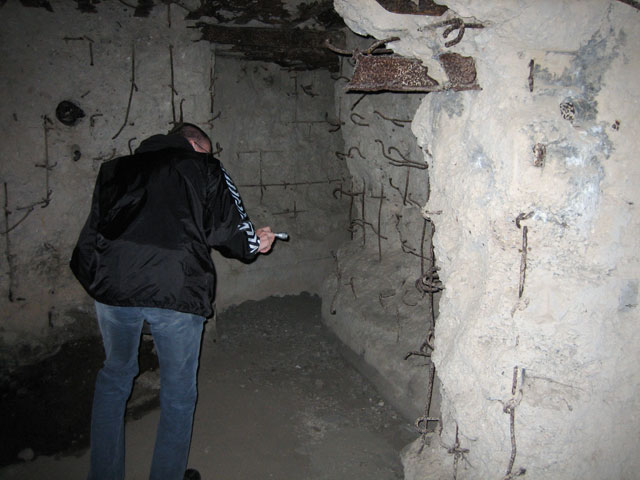
(Inside the heavily destroyed Bunker.)

(Soil filled lower level.)
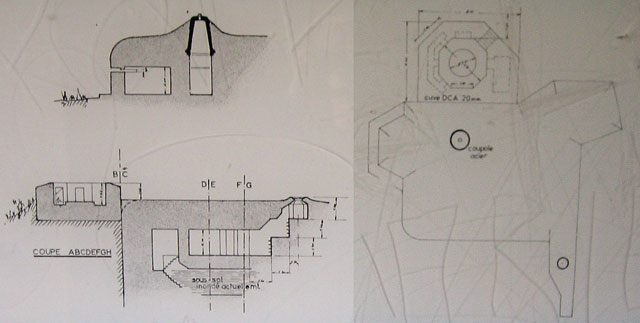
(Plan of the Bunker.)
This was a rather nice end of our
tour, to see a not touristy open bunker like I prefer usually.
Somewhat balancing out our dismal experience with Crisbecq battery.
We went back to our car, had a cold coke and decided to finally head
back home. We left the battery at 3PM - and until Bayeux our ride
back was a breeze.
And then our luck ran out, we got
stuck in a massive traffic jam in northern france. It took us a few
hours to finally get going at more then walking speed! So our plan
on arriving around midnight did not work out at all, instead we
arrived at 2AM. But safe and in one piece, thats the most important
part...
All in all it was a very interesting,
yet taxing journey, luckily not really expensive considering what we
managed to see during those days. Including all the entrance fees,
gas, lodging and food and even buying new rubber boots, we spend 180
Euros per person only. If we had bought this normandy pass, we might
have saved another 5-10 Euros, but... something always could be
improved. .
|
|
|
|
|
|
|
|
|
Last update 12/18/2009 |
|
|